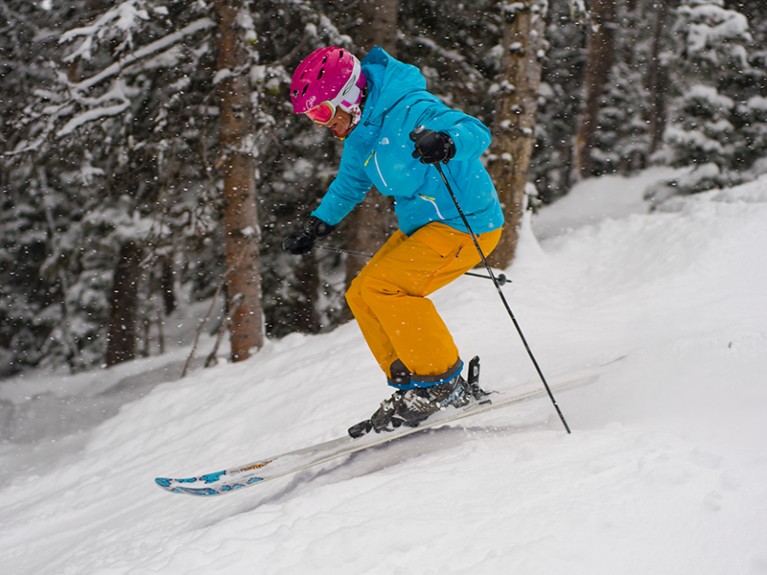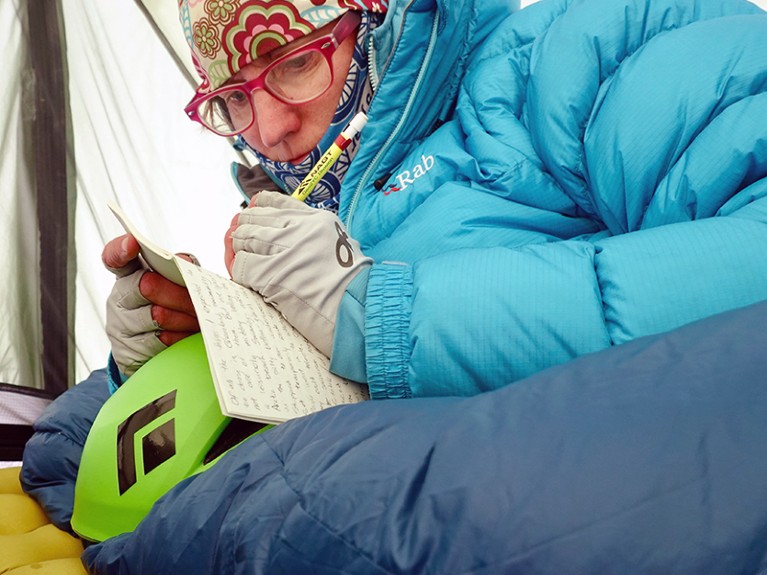
Karin Kirk skiing.Credit: Chris Kerr
Karin Kirk is a freelance science journalist who has built a career on icy ground. She lives in Bozeman, Montana, a corner of the northwestern United States known for its snow-capped mountains and vast wilderness areas. There, she balances her work as a science writer and climate educator with her job as a skiing instructor and ridge guide — a professional with the expertise to guide skiers through trails beyond the ski lifts, accessible only by hiking.
Kirk tells Nature how she finds a balance between her two interrelated careers.
How did you get started on your multidimensional career path?
I was teaching undergraduates at Skidmore College in Saratoga Springs, New York — one of my first jobs after graduating in geology from Montana State University in Bozeman — and there was a nearby ski area that had night skiing. I found I could teach geology during the day and teach skiing at night. Ever since then, I’ve never let go of either of those pieces of my career. It’s an ongoing struggle,but my motivation to keep the right balance between work and life has been really strong. If someone right now offered me the ultimate dream writing job, but it was full time and it meant I couldn’t ski or go out and do all these other things I do, I don’t think I would accept it.
I feel really fortunate. Building a career is hard for everyone, but it’s harder for people in minority groups, first-generation university students and people who cannot afford to take big financial risks like going freelance. I am incredibly lucky that my husband and I could float for a bit and live on a reduced income when I started freelancing.
What challenges have you faced in maintaining that balance?
In science, I’ve had colleagues who really don’t know what to make of the fact that I have serious professional commitments that are not to do with research. Not everyone appreciates that, and some people see me as uncommitted. It was a theme more when I was in academia, because people are very used to the total dedication to that path.
Probably the hardest thing for me was getting started as a freelance science writer once I left academia. Going out on one’s own is exhilarating and terrifying in equal measure. You have moments of triumph. But then you have a lot of setbacks and moments that make you doubt yourself. Those first few years were a battle.
How did you navigate the leap into the unpredictable world of freelancing?
At first, I expanded my ski teaching, which helped financially and restored my energy and optimism when I needed it most.
The overall solution that worked for me was to find outlets for which I could be a regular writer, rather than chasing one-off assignments. After a couple of years I developed a nice rotation of writing about climate change, geology and skiing. Switching between topics kept me fresh and productive, and it was enough to pay the bills. Building relationships with editors also gave me space to explore ideas without having to prove myself with each new article, plus the pay was predictable so I could meter out my time accordingly. That’s when I felt like I’d found my groove, and everything became fun rather than scary.
When do you feel most successful in your science-communication work?
My personal priority is to reach as wide an audience as I can and talk to people in all different circumstances. I am super happy when I see my work reach an audience way outside my peers and colleagues. For example, some of my writing and infographics around electric-vehicle efficiency, which were published by the news service Yale Climate Connections, got picked up by MotorTrend magazine and referenced in two articles. I’m not the person who’s going to go and pitch to an automotive magazine, but for them to find my work, write about it and then recommend my article to their readers was awesome. It connected with a way different audience than I expected.

Karin takes notes after navigating glaciers in Greenland.Credit: Karin Kirk
In what ways is your work in geoscience complementary to your work as a skiing instructor and ridge guide?
As a guide here at Bridger Bowl Ridge, I love to talk about the geology of the mountain range and the intricacies of the rock. The summit is made of Mississippian-age Madison limestone (that’s around 325 million years old), the same rock I studied for my master’s thesis. It has brachiopod fossils and collapse breccias and fabulous chert lenses. At the crest of the range, the rocks have been uplifted to a near-vertical position, forming sheer walls of limestone that are a total rush to weave through on skis or a snowboard. My goal, as both a skiing instructor and a geoscience communicator, is to help people feel comfortable. Skiing is a scary sport. It’s important to see where a person is, understand what they’re feeling, and work with that. Fear can be paralysing. But when you feel comfortable, you can do amazing things. That’s where everything overlaps for me.
The other obvious overlap is climate change — the future is grim for the ski industry. But to me, that’s a very minor consequence of climate change: it doesn’t really matter, compared with other consequences. Skiing’s really fun, and it’s a way of life if you live near a ski area. But I’m more concerned for the water in the snowpack than my ability to play on the snowpack, and so is everybody here. Snow has a really special role in the hydrological cycle, because it stores water and releases it slowly. The way snow reflects sunlight is also integral to nature.
I think the best thing the ski industry can do, when we have guests up in these Alpine environments, is to be service educators. We need to say, “Skiing on snow is fun, but here are all the ways that snow is important in this ecosystem.”
What advice would you give scientists who want to communicate their work effectively?
We’re in a golden age of communication, but it can also be a media minefield. There’s this insatiable hunger for information, so the opportunities for science communication have never been greater. There are also so many venues for communicating science, whether you do it formally and you want to make a career out of it, or informally as part of another job. You can do it as a community leader — I’ve gone out and had hundreds of conversations about climate with voters, and I’ve been training others to do the same. If you can bring your science into your hobby, the way I’ve done with skiing and geoscience, you can use a shared passion to start conversations with people. My advice would be to try different lanes. Continue to iterate, and if you start to get some resonance with an audience, a topic or a method, then cultivate that.

 I started fossil hunting in my 60s — now I have more than 2,000 pieces
I started fossil hunting in my 60s — now I have more than 2,000 pieces
 Organize your –80 °C freezer to save time and prevent frozen fingertips
Organize your –80 °C freezer to save time and prevent frozen fingertips
 How sharing your science in an opinion piece can boost your career
How sharing your science in an opinion piece can boost your career








